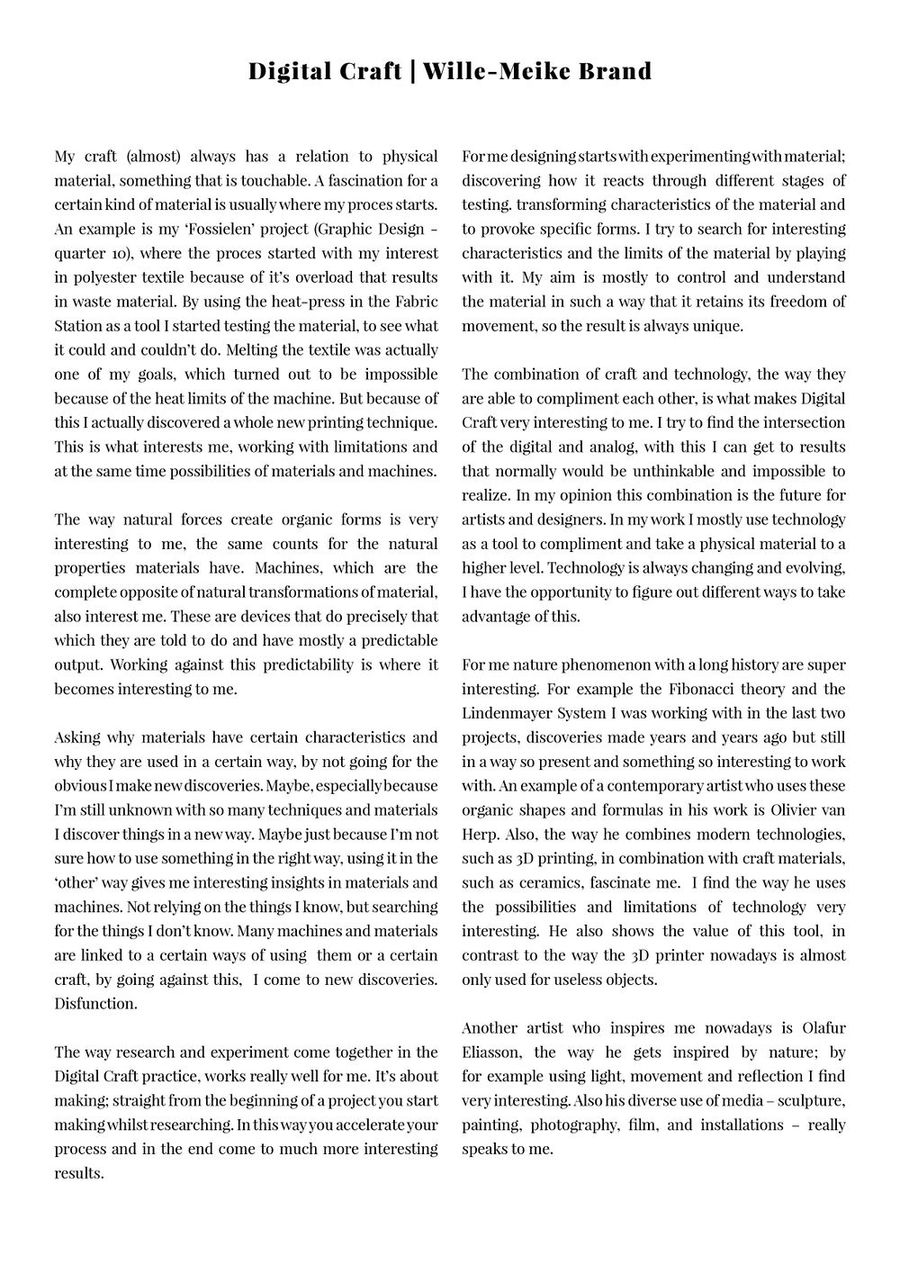User:Meikebrand/UTC/research
See text below image.
My craft (almost) always has a relation to physical material, something that is touchable. A fascination for a certain kind of material is usually where my proces starts. An example is my ‘Fossielen’ project (Graphic Design - quarter 10), where the proces started with my interest in polyester textile because of it’s overload that results in waste material. By using the heat-press in the Fabric Station as a tool I started testing the material, to see what it could and couldn’t do. Melting the textile was actually one of my goals, which turned out to be impossible because of the heat limits of the machine. But because of this I actually discovered a whole new printing technique. This is what interests me, working with limitations and at the same time possibilities of materials and machines.
The way natural forces create organic forms is very interesting to me, the same counts for the natural properties materials have. Machines, which are the complete opposite of natural transformations of material, also interest me. These are devices that do precisely that which they are told to do and have mostly a predictable output. Working against this predictability is where it becomes interesting to me.
Asking why materials have certain characteristics and why they are used in a certain way, by not going for the obvious I make new discoveries. Maybe, especially because I’m still unknown with so many techniques and materials I discover things in a new way. Maybe just because I’m not sure how to use something in the right way, using it in the ‘other’ way gives me interesting insights in materials and machines. Not relying on the things I know, but searching for the things I don’t know. Many machines and materials are linked to a certain ways of using them or a certain craft, by going against this, I come to new discoveries. Disfunction.
The way research and experiment come together in the Digital Craft practice, works really well for me. It’s about making; straight from the beginning of a project you start making whilst researching. In this way you accelerate your process and in the end come to much more interesting results.
For me designing starts with experimenting with material; discovering how it reacts through different stages of testing. transforming characteristics of the material and to provoke specific forms. I try to search for interesting characteristics and the limits of the material by playing with it. My aim is mostly to control and understand the material in such a way that it retains its freedom of movement, so the result is always unique.
The combination of craft and technology, the way they are able to compliment each other, is what makes Digital Craft very interesting to me. I try to find the intersection of the digital and analog, with this I can get to results that normally would be unthinkable and impossible to realize. In my opinion this combination is the future for artists and designers. In my work I mostly use technology as a tool to compliment and take a physical material to a higher level. Technology is always changing and evolving, I have the opportunity to figure out different ways to take advantage of this.
For me nature phenomenon with a long history are super interesting. For example the Fibonacci theory and the Lindenmayer System I was working with in the last two projects, discoveries made years and years ago but still in a way so present and something so interesting to work with. An example of a contemporary artist who uses these organic shapes and formulas in his work is Olivier van Herp. Also, the way he combines modern technologies, such as 3D printing, in combination with craft materials, such as ceramics, fascinate me. I find the way he uses the possibilities and limitations of technology very interesting. He also shows the value of this tool, in contrast to the way the 3D printer nowadays is almost only used for useless objects.
Another artist who inspires me nowadays is Olafur Eliasson, the way he gets inspired by nature; by for example using light, movement and reflection I find very interesting. Also his diverse use of media – sculpture, painting, photography, film, and installations – really speaks to me.
________________________

The Electronic as Post-optimal Object the electronic objects we have now are nog going to evolve anymore. It is possible to make an optimal electronic object nowadays.
Semiotic Understanding signs. Designers role is to make a nice readable package. Not about understanding what is actually in the package.
Dematerialization Things become seamless in our environment. We’ve made the smallest phone that could have been used, so now we’re making bigger ones that fit our needs. What is the actual object, what is the value?
User friendliness How can we make this less of a generalization? “We all are a little bit crazy” It leads to very restricted ways that we should use our objects - in order to protect the image of their product. What is strange, a not perfect situation for a marketeer User unfriendliness - poetry —> user unfriendly text. Mixing up things that actually make things more meaningful. Making things smooth is not the only way, try to provoke.
